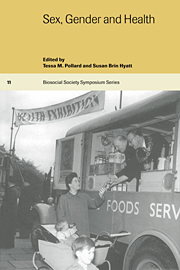Book contents
- Frontmatter
- Contents
- List of contributors
- Preface
- 1 Sex, gender and health: integrating biological and social perspectives
- 2 Parental manipulation of postnatal survival and well-being: are parental sex preferences adaptive?
- 3 Gender bias in South Asia: effects on child growth and nutritional status
- 4 Sex, gender and cardiovascular disease
- 5 Social meanings and sexual bodies: gender, sexuality and barriers to women's health care
- 6 Poverty and the medicalisation of motherhood
- 7 The vanishing woman: gender and population health
- 8 Agency, opposition and resistance: a systemic approach to psychological illness in sub-dominant groups
- Glossary
- Index
6 - Poverty and the medicalisation of motherhood
Published online by Cambridge University Press: 07 December 2009
- Frontmatter
- Contents
- List of contributors
- Preface
- 1 Sex, gender and health: integrating biological and social perspectives
- 2 Parental manipulation of postnatal survival and well-being: are parental sex preferences adaptive?
- 3 Gender bias in South Asia: effects on child growth and nutritional status
- 4 Sex, gender and cardiovascular disease
- 5 Social meanings and sexual bodies: gender, sexuality and barriers to women's health care
- 6 Poverty and the medicalisation of motherhood
- 7 The vanishing woman: gender and population health
- 8 Agency, opposition and resistance: a systemic approach to psychological illness in sub-dominant groups
- Glossary
- Index
Summary
Medicalisation and modernity
Medicalisation has become one of the primary metaphors through which many contemporary social phenomena are understood and addressed. By ‘medicalisation,’ I mean the translation of the appearances, behaviours, or ‘lifestyles’ of individuals occupying particular niches defined as socially problematic into the language of medicine. Through this process, troublesome populations become transformed from living testimonials to the possible deficiencies inherent in the political economy of contemporary life, into ‘patients’ in need of therapeutic treatment. Both Hopper (1988) and Mathieu (1993), for example, have illustrated how the increase in homelessness in New York City in the 1980s was explained as the result of the deinstitutionalisation of long-term mental patients and of homeless individuals' drug and alcohol addictions, rather than as a reflection of the loss of affordable housing for those now relegated to the margins of the emergent global economy. Each of these authors demonstrates that the re-interpretation of social distress as evidence of individual pathologies, representations which have dominated the press and resultant public policy debates about the increase in homelessness in the United States, have served to mask a much greater problem: that is, the deleterious social consequences of the changing economies of urban spaces.
This logic of linking behaviours seen as socially problematic to putative biological abnormalities has attained a great deal of currency in public discourse. As Urla and Terry (1995:1) note, ‘[T]he notion that individuals identified as socially deviant are somatically different from ‘normal’ people is a peculiarly recurring idea that is deeply rooted in Western scientific and popular thought’.
- Type
- Chapter
- Information
- Sex, Gender and Health , pp. 94 - 117Publisher: Cambridge University PressPrint publication year: 1999
- 3
- Cited by



